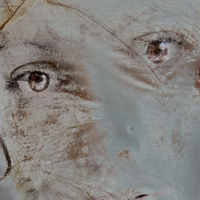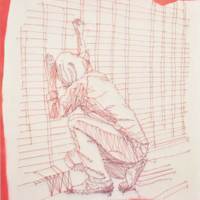
Tethered from The Scarlet Cord installation
The Scarlet Cord by Pamela Alderman is an installation that examines child sex slavery. Her website describes it 'As visitors step inside a 40-foot storage container filled with thirty doors, they enter a secret world. This dark world crosses religious and social economic borders to sell our children for sex. The twisting scarlet cord depicts the trauma bond that connects the children to their traffickers. The weathered doors represent these abused children whose youthful minds have become knotted. Alderman’s art—dedicated to these suffering children tethered within the sex industry—calls for compassionate action.'
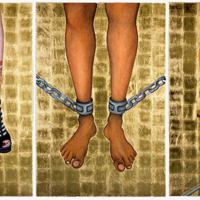
House Slave - Field Slave I and II
'House Slave - Field Slave: A Portrait of Contemporary Slavery' by Nicola Green was first exhibited at the Dulwich Picture Gallery in October 2007. It was then exhibited as part of Haringey's Black History Month at Bruce Castle Museum in October - December 2010. Nicola's triptych is now in the permanent collection at the International Slavery Museum in Liverpool.
Nicola Green's portrait of contemporary slavery 'House Slave - Field Slave' was made for and in collaboration with Anti-Slavery International to commemorate the anniversary of the abolition of the slave trade in 2007. The exhibition consists of a large 'altarpiece' scale triptych with preparatory studies. These are set alongside artefacts of contemporary slavery from the International Slavery Museum in Liverpool and the extraordinary photos and text from Anti-Slavery International, which inspired this work. The painting tells the story of contemporary slavery. There are an estimated 12 million people in the world today who are still enslaved - even though the British slave trade was abolished 200 years ago.
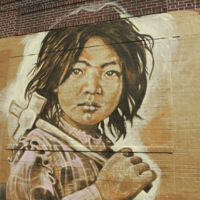
Child Labor in Katmandu, Nepal
Indira works in a granite quarry near Katmandu. She is 7 years old. The granite is sent to Britain to provide stone tiles for patios. Children are paid the equivalent of 25 cents a day to perform tiring and dangerous work with little or no safety gear. Approximately 32,000 children in Nepal work in stone quarries. Some are as young as 5 years old Many work besides their parents who are in debt bondage with little hope of escaping. Some live at the work site which is watched by guards who forbid them from leaving. The children are forced to perform hazardous jobs and if they refuse the employer withholds food from the family. Eradicating child labor from Nepal is difficult because it is fundamental to the economy. This mural was painted in conjunction with the 6th Annual Welling Court Mural Project in Astoria, Queens. It is located on 12th Street in between Welling Court and 30th Rd.
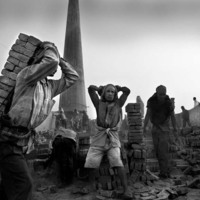
Carriers, Nepal
Entire families are in bonded labor slavery. Often, families get a loan for an emergency or to pay a broker a fee for getting hired on a new job. Slaveholders, the only people near with any money to lend, trick the borrowers into slavery through illegal, exorbitant interest rates that are impossible to repay. Children inherit the bogus debt from their parents. Generations of families have been enslaved for a loan of just $18.

Brothers Carrying Stone, Nepal
Each day, children make several trips down the mountain, delivering stones from higher up in the Himalayas. They use makeshift harnesses out of ropes and sticks, strapping the stones to their heads and backs. Many of them come from families where everyone is trapped in debt bondage slavery. One of the mothers describes what it was like to be in slavery, “Neither can we die, nor can we survive.”

Children Can't Stop It But You Can... Stop Child Labour
Campaign by the United Nations to bring an end to child labour. The hand-prints reaching out gesture towards the absent child and in doing so resists a common trope within humanitarian campaigns - relying on images of the suffering child to evoke sympathy.
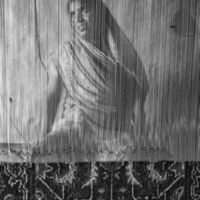
Modern Slavery, Indian Weaver
This image depicts 'Jadawati, a weaver, she is working on a 24 feet carpet which will take her nearly 40 days to complete. As a bonded labourer, she is paid 60 rupees a day, a rate nearly half the minimum wages entitled to her as per the law. The carpet that might sell for 25,000 rupees or more will have earned Jadawati less than 2,500.' The composition of the image gestures towards a sense of imprisonment; the woman is visible behind the fabric weave which acts as an intricate prison. As the rug fabric moves towards completion the figure of Jadawati slowly disappears behind the pattern, as the object of consumption obscures the human cost of production.
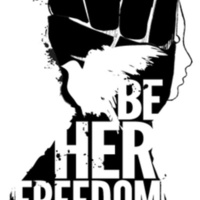
Be Her Freedom
The Be Her Freedom campaign is part pf the A21 movement which comprises of individuals, organizations, government officials, and members of the public who are committed to abolishing injustice in the 21st century. The image replaces the shackled pleading hands of past antislavery campaigns with a clenched fist - a symbol of self-determination and self-liberation.
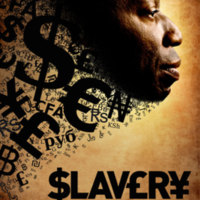
Slavery Not A Thing of the Past
Antislavery International commissioned poster. By foregrounding international currency symbols the image draws attention to the relationship between slavery and capitalism.
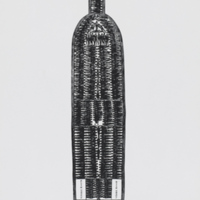
Absolut Power
This piece of art by Hank Willis Thomas is based on the Brookes slave ship image which was made famous by the British abolitionist campaign against transatlantic slavery. The artist said of the piece that “Racism is the most successful advertising campaign of all time... Africans have hundreds if not thousands of years of culture. Having all of these people packed into ships and then told they’re all the same, reducing them to a single identity—that’s absolute power.”

Woman to Go
One major trope in 19th-century antislavery visual culture was the auction block, which featured in the Liberator masthead from 1831 to 1865 as a scene with crowds of onlookers. In 21st-century antislavery imagery, the auction block is back. In 2010, the Task Force on Human Trafficking opened an installation called “Woman to Go,” featuring real women sitting or standing on blocks behind glass in a shopping center in Tel Aviv, each with a price tag and barcode.
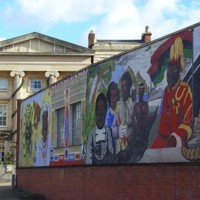
Reading Mural Black History
The project began in 1987 when Central Club approached Reading Borough Council about the possibility of a mural project. A project steering group was set up consisting of representatives of Central Club, Reading Borough Council and Berkshire County Council (who then ran Central Club as part of the Youth and Community Service). It was agreed that the project should aim to achieve a number of objectives:
· A high quality visual artwork
· Community involvement – both Central Club members and the wider community
· Reflecting African Caribbean culture, since Central Club had a high proportion of African Caribbean members
In 1988 a number of artists were interviewed, and Alan Howard was offered the commission. Alan was keen to encourage the involvement of Central Club members both in a consultative capacity but also more directly in the design and execution of the mural. An apprenticeship scheme was established, where a limited number of people were offered the opportunity to work alongside Alan and receive training in planning, design and technical skills.
The process of planning the mural involved a number of steps:
· Wide ranging discussions with Central Club members and the wider African Caribbean community
· Consultation with funders – Reading Borough Council and Earley Charities
· Consultation with neighbouring residents and businesses in the London Street area
Out of this process the theme for the mural emerged, and it was agreed that the mural should depict the positive role that black people have played throughout history, including in Reading itself. The mural therefore includes figures such as Harriet Tubman, Martin Luther King and Bob Marley as well as Reading-based people involved in founding Central Club. The final panel of the mural and the various symbols look to the future and depicts a number of tools – positive and negative – that people use to shape the future.
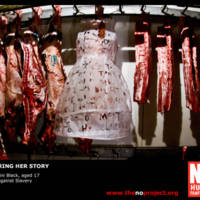
Wearing Her Story
In contrast to the trope that brands individuals’ experiences onto their backs, the No Project released a poster in 2012 titled “Wearing Her Story,” made by the artist Ismini Black. A woman’s dress hangs alongside carcasses in a butcher’s window. There are letters cut out of the dress and the words are impossible to piece together. By replacing a woman’s body with just her dress, the poster refuses to inscribe slavery’s story onto her flesh. She might wear her story like a removable item of clothing, but it is not the last word on her total identity. Instead it remains impossible to grasp and therefore consume, unlike the poster’s chunks of meat.
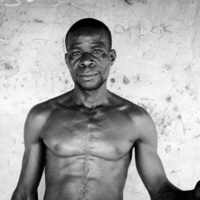
Slavery in Lake Volta
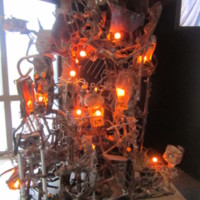
Freedom sculpture
